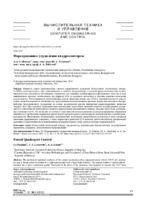| dc.contributor.author | Пэнхао, Гу | |
| dc.contributor.author | Леоновец, Ю. А. | |
| dc.contributor.author | Лобатый, А. А. | |
| dc.coverage.spatial | Минск | ru |
| dc.date.accessioned | 2023-04-18T07:31:05Z | |
| dc.date.available | 2023-04-18T07:31:05Z | |
| dc.date.issued | 2023 | |
| dc.identifier.citation | Пэнхао, Гу. Форсированное управление квадрокоптером = Forced Quadcopter Control / Гу Пэнхао, Ю. А. Леоновец, А. А. Лобатый // Наука и техника. – 2023. – № 2. – С. 91-95. | ru |
| dc.identifier.uri | https://rep.bntu.by/handle/data/127371 | |
| dc.description.abstract | Решается задача аналитического синтеза управляющего ускорения беспилотного летательного аппарата (БЛА) мультироторного типа применительно к легкому квадрокоптеру с высокой продолжительностью полета. Аналитически определяется оптимальное управление при заданном минимизируемом функционале качества в виде минимального времени, необходимого для перевода БЛА из заданного начального в заданное конечное положение в пространстве. Рассматривается математическая модель движения центра масс БЛА в заданной плоскости относительно земной поверхности. Особенностью предлагаемой методики является решение задачи максимального быстродействия (форсированного управления) на основе рассмотрения законов кинематики равноускоренного движения твердого тела. При заданных характеристиках максимально допустимых значений скорости и управляющего ускорения БЛА аналитически вычисляются моменты переключения управляющего сигнала, которые могут быть реализованы в автопилоте БЛА. Это позволяет в отличие от классических методов решения задачи форсированного управления избавиться от необходимости решения двухточечной краевой задачи и рассмотрения дополнительных условий трансверсальности. Проведенное компьютерное моделирование полученных аналитически результатов в виде процессов изменения управляющего ускорения, а также параметров движения БЛА показало работоспособность предлагаемой методики и перспективность ее использования на первоначальном этапе синтеза системы управления БЛА. | ru |
| dc.language.iso | ru | ru |
| dc.publisher | БНТУ | ru |
| dc.title | Форсированное управление квадрокоптером | ru |
| dc.title.alternative | Forced Quadcopter Control | ru |
| dc.type | Article | ru |
| dc.identifier.doi | 10.21122/2227-1031-2023-22-2-91-95 | |
| local.description.annotation | The problem of analytical synthesis of the control acceleration of an unmanned aerial vehicle (UAV) of a multirotor type is being solved in relation to a light quadrocopter with a high flight duration. The optimal control is analytically determined for a given minimized quality functional in the form of the minimum time required to transfer the UAV from a given initial to a given final position in space. A mathematical model of the movement of the UAV mass center in a given plane relative to the earth's surface is considered. A feature of the proposed technique is the solution of the problem of maximum speed (forced control) based on the consideration of the laws of kinematics of uniformly accelerated motion of a rigid body. For given characteristics of the maximum allowable speed and control acceleration of the UAV, the moments of switching of the control signal are analytically calculated, which can be implemented in the UAV autopilot. This allows, in contrast to classical methods for solving the problem of forced control, to get rid of the need to solve a two-point boundary value problem and consider additional transversality conditions. The computer simulation of the obtained analytical results in the form of processes of changing the control acceleration, as well as the UAV motion parameters, has shown the efficiency of the proposed technique and the prospects for its use at the initial stage of the synthesis of the UAV control system. | ru |

